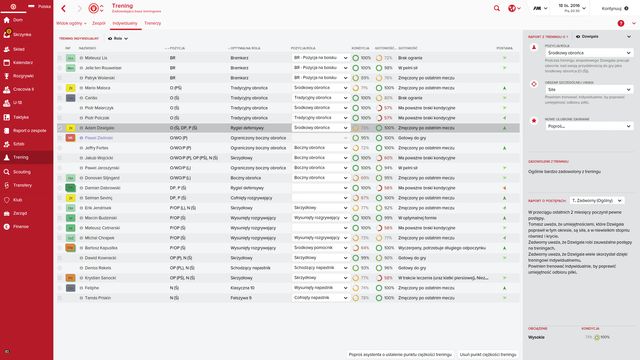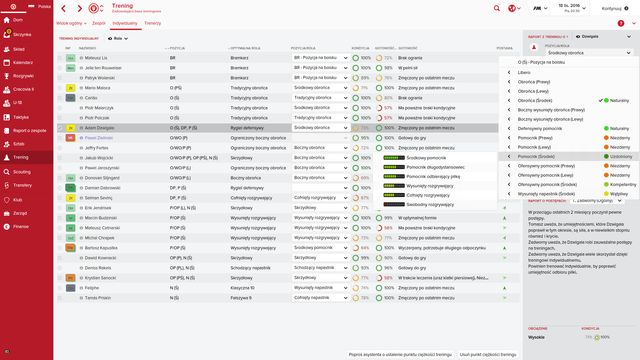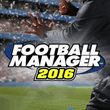Football Manager 2016: Individual training

Training with the entire team is only a part of the entire coaching routine of your players. Personalizing your expectations towards them lets you develop specific attributes in individual players. Individual training can be divided into 3 categories: focusing on the selected attribute of the player, training the skills connected with his role in the field and learning of the preferred move.
Select, for each player, the characteristic that they should attach special care to, while training. Remember however that to make them relevant to the role of the player in the field, e.g. for the outside defender, quickness may prove more useful, if you have the preference for their offensive raids along the field. Midfielder, on the other hand, should work on, e.g. passes and forward - on finishing off the action.
Role training
While you select, for the player, the role (position in the field) that he is to work at, you set individual training for that player which consists in development of all the properties that are useful in that position. This way, you should specialize your players in playing on positions that they occupy during the match. When your midfielder plays as a "traditional defender", it is those properties that you should be developing in him. Remember that while selecting tactic, apart from the player's position (e.g. the midfielder), you also specify the player's role ("traditional defender", "ball-playing", "midfielder") and his function. Individual training allows you to specify the role and train those of the attributes that are connected with that role. Differences here concern several attributes only and, regardless of the role you select, midfielder will always be training "tackle" or "cover".

While defining individual training for the selected player, you should predominantly predict on which position you see him playing (players can play on various positions e.g. defensive midfielder/center midfielder). The key aspect is to find out how the player is doing on the position that you have assigned him to (the bar filed up in green represents "Neutral", i.e. the player's best adjustment to playing on that position. After you pick the position, consider the role that the player is to assume in the team. Only on that basis, match training with his individual needs, thanks to which you will be certain that you are training the appropriate aspect.
When you train a player for a new position, they grow used to playing on that position. This way, you can try to move outside defenders, or e.g. the midfielder and give him a more offensive position. This lets you expand the team's reserves without the necessity to buy new players (money saves). Just remember not to get carried away too much, e.g. by moving the midfielder to the position of the forward.
Attribute training (special care area)
In the case of training a specific attribute, you focus on one attribute only. You can change it at any moment, by predefining training routine for the entire season. Just like in the case of the role training/position training, also here, you should be selecting those of the attributes that you a given player should work on. It is much easier to do that in the case of a youngster than in the case of an older player. While selecting the attribute that you want to focus on, it is a good idea to improve on the players' shortcomings, and not try to max out on one of the attributes. While focusing on those of the attributes that are the most important for the player on his position, pick the ones that are the weakest in him. By focusing training on those attributes, you can improve on the greatest shortcomings of the player, which increases his usefulness in the field. Improving on weaknesses is also faster than training strong points of that player.
Preferred move training
While selecting the Preferred move for the player, you can also choose how the player should behave in the field. For example, you can ask him to avoid playing with the weaker leg. While selecting the appropriate coach from the list, do not forget about his properties (if you want to train defensive play, pick the coach whose responsibility it is to train defensive play). Player can also learn preferred moves from older players, if he is a youngster and you initiate (by selecting Interaction -> ask for tutorship) tutorship of the youngster, by the older player .
Preferred moves also add to the workload of the player and they decrease his effectiveness during other training sessions. Therefore, make sure that learning the move is going to be beneficial (e.g. rarer long-distance shots in the player that is it underdeveloped in).
You are not permitted to copy any image, text or info from this page. This site is not associated with and/or endorsed by the developers and the publishers. All logos and images are copyrighted by their respective owners.
Copyright © 2000 - 2025 Webedia Polska SA for gamepressure.com, unofficial game guides, walkthroughs, secrets, game tips, maps & strategies for top games.
